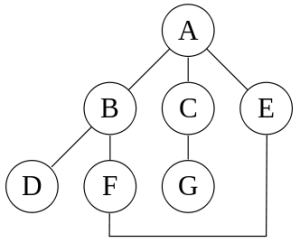Depth-first search (DFS) is an algorithm for traversing or searching tree or graph data structures. One starts at the root (selecting some arbitrary node as the root in the case of a graph) and explores as far as possible along each branch before backtracking.A version of depth-first search was investigated in the 19th century by French mathematician Charles Pierre Trémaux as a strategy for solving mazes.
Properties of DFS
The time and space analysis of DFS differs according to its application area. In theoretical computer science, DFS is typically used to traverse an entire graph, and takes time O(|E|), linear in the size of the graph. In these applications it also uses space O(|V|) in the worst case to store the stack of vertices on the current search path as well as the set of already-visited vertices. Thus, in this setting, the time and space bounds are the same as for breadth-first search and the choice of which of these two algorithms to use depends less on their complexity and more on the different properties of the vertex orderings the two algorithms produce.
For applications of DFS in relation to specific domains, such as searching for solutions in artificial intelligence or web-crawling, the graph to be traversed is often either too large to visit in its entirety or infinite (DFS may suffer from non-termination). In such cases, search is only performed to a limited depth; due to limited resources, such as memory or disk space, one typically does not use data structures to keep track of the set of all previously visited vertices. When search is performed to a limited depth, the time is still linear in terms of the number of expanded vertices and edges (although this number is not the same as the size of the entire graph because some vertices may be searched more than once and others not at all) but the space complexity of this variant of DFS is only proportional to the depth limit, and as a result, is much smaller than the space needed for searching to the same depth using breadth-first search. For such applications, DFS also lends itself much better to heuristic methods for choosing a likely-looking branch. When an appropriate depth limit is not known a priori, iterative deepening depth-first search applies DFS repeatedly with a sequence of increasing limits. In the artificial intelligence mode of analysis, with a branching factor greater than one, iterative deepening increases the running time by only a constant factor over the case in which the correct depth limit is known due to the geometric growth of the number of nodes per level.
DFS may also be used to collect a sample of graph nodes. However, incomplete DFS, similarly to incomplete BFS, is biased towards nodes of high degree.
C programme of DFS
#include<stdio.h>
#include<conio.h>
int a[20][20],reach[20],n;
void dfs(int v)
{
int i;
reach[v]=1;
for(i=1;i<=n;i++)
if(a[v][i] && !reach[i])
{
printf("n %d->%d",v,i);
dfs(i);
}
}
void main()
{
int i,j,count=0;
clrscr();
printf("n Enter number of vertices:");
scanf("%d",&n);
for(i=1;i<=n;i++)
{
reach[i]=0;
for(j=1;j<=n;j++)
a[i][j]=0;
}
printf("n Enter the adjacency matrix:n");
for(i=1;i<=n;i++)
for(j=1;j<=n;j++)
scanf("%d",&a[i][j]);
dfs(1);
printf("n");
for(i=1;i<=n;i++)
{
if(reach[i])
count++;
}
if(count==n)
printf("n Graph is connected");
else
printf("n Graph is not connected");
getch();
